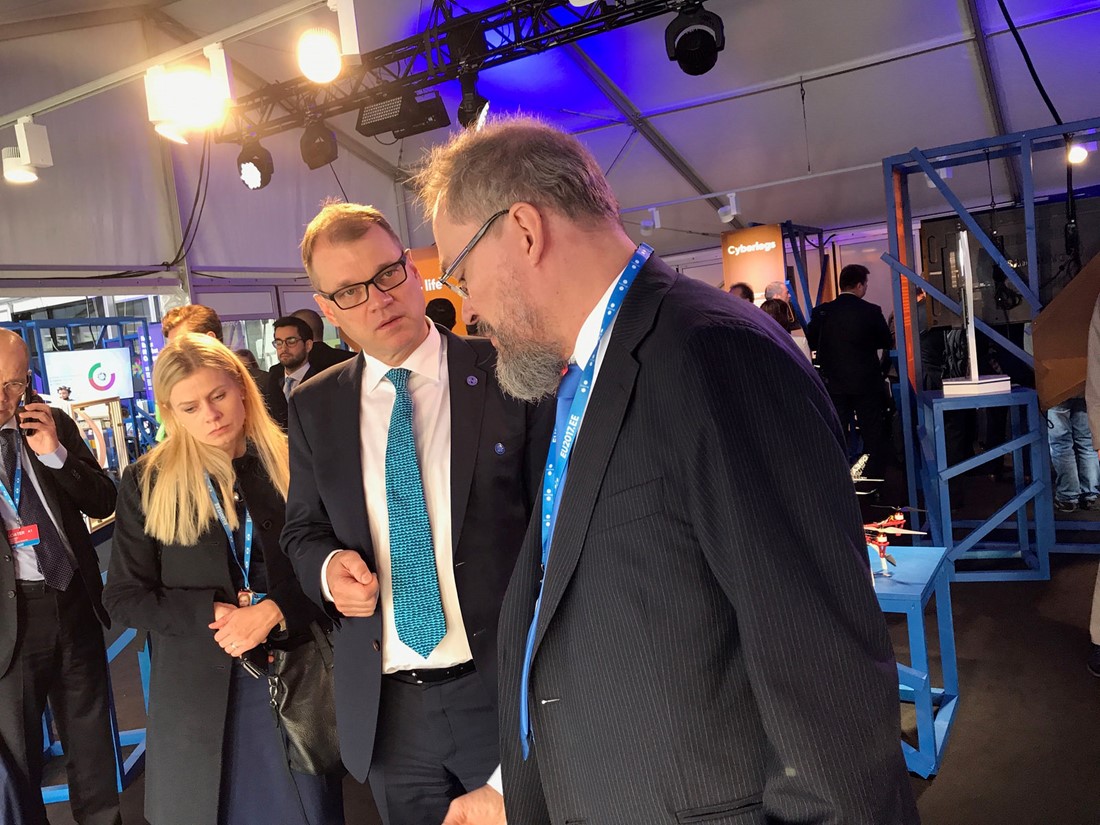The Graphene Flagship Shines at The Tallinn Digital Summit
At the Tallinn Digital Summit, the Graphene Flagship showcased the potential of graphene and related materials to Heads of State and Government from across Europe with an array of interactive demonstrators and prototypes.
At the Tallinn Digital Summit, a forum for Heads of State and Government from across Europe to discuss digital innovation and Europe’s digital future, the Graphene Flagship showcased the potential of graphene and related materials with an array of interactive demonstrators and prototypes.

In the Graphene Flagship exhibition area there was an “electronic nose” capable of distinguishing different gases (left), a graphene-based chromatic eye that uses different graphene photodetectors in an array for broadband optical sensing, and a flexible, graphene based terahertz detector which enables wireless ultrahigh-speed communication. There was also a large area solar cell with high efficiency, retinal implants which can serve as optical prostheses for people who have lost their sight, and a graphene sensor able to detect the electrical activity of the brain. As an example of near market products there was also a motorcycle helmet exploiting graphene in its frame, and a drone with graphene propellers. Graphene Flagship partner Airbus also displayed a model aircraft which illustrates how their current graphene materials research aims to improve their future aircrafts.

All of these different demonstrators, prototypes or products were presented to heads of state and governments as they toured the Tallinn Digital Summit and it was a great opportunity for the Graphene Flagship and its members to present the potential of graphene and related materials and the work that is going on within the Graphene Flagship. Visitors to the Graphene Flagship exhibition area included Maris Kucinskis (Prime Minister of Latvia), Beata Szydlo (Prime Minister of Poland), Juha Sipila (Prime Minister of Finland) (right), Miro Cerar (Prime Minister of Slovenia), Paolo Gentiloni (Prime Minister of Italy) and Alexis Tsipras (Prime Minister of Greece). There were also numerous visits by local school children and it was a fantastic opportunity for the Graphene Flagship to inspire the scientists of tomorrow.
Professor Jari Kinaret, the Director of the Graphene Flagship, stated “The Tallinn Digital Summit allowed us to exhibit some of the many results the Graphene Flagship has achieved during its first four years. This was a great honour and a unique opportunity for us to show the highest decision makers what Europe can achieve by working together towards a common goal, and demonstrates that the Flagship is well on its way to realise its ambitious goals”.
Professor Andrea C. Ferrari, Science and Technology Officer of the Graphene Flagship and Chair of its Management Panel, stated "As the Graphene Flagship steadily progresses in its science, technology and innovation roadmap, an ever increasing number of demonstrators and products are being developed. Tens of start-up and established companies and hundreds of patents are moving graphene and related materials from the lab towards the factory floor. These have a lot to offer to contribute to the digital innovation of Europe, as was showcased by a selection of demonstrators during this key event for the European Union".
High resolution images can be found in the Graphene Flagship image library at:
https://www.flickr.com/photos/151519747@N06/albums
Graphene Flagship technology exhibits and exhibiting partners
IoT and sensors
-
Electronic Nose – University of Tartu (Estonia)
-
Chromatic Eye – University of Cambridge, Nokia, Emberion, ICFO (UK, Finland, Spain)
Datacoms
-
Flexible WiFi Receiver – RWTH Aachen and AMO (Germany)
-
High Speed Data Transfer – CNIT, Ericsson, Nokia and IMEC (Italy, Sweden, Finland, Belgium)
-
Flexible Terahertz Detector – Chalmers University of Technology (Sweden)
Composites
-
Drone – University of Manchester (UK)
-
Motorcycle Helmet – IIT- Istituto Italiano di Tecnologia, MomoDesign (Italy)
-
Airbus Model – Airbus (France, Spain)
Health
-
Retinal Prosthesis Interface – Catalan Institute of Nanoscience and Nanotechnology – ICN2 (Spain)
-
Brain Sensor – Catalan Institute of Nanoscience and Nanotechnology – ICN2 (Spain)
Energy
-
Solar Cell – Universita' di Roma Tor Vergata (Italy), Technological Educational Institute of Crete (Greece)
The Tallinn Digital Summit allowed us to exhibit some of the many results the Graphene Flagship has achieved during its first four years"
Professor, Director of the Graphene Flagship



